If you’re following a gluten-free diet but still want to enjoy pizza, it’s essential to understand the calorie content of gluten free pizza. The calorie content of gluten-free pizza can vary depending on the type of crust, toppings, and size of the slice. Being aware of these factors can help you make informed choices and maintain a balanced diet.
- Counting gluten free pizza calories is important for individuals on a gluten-free diet.
- Calorie content can vary based on crust, toppings, and slice size.
- Opt for low-calorie ingredients and toppings, such as part-skim cheese and vegetables.
- Practice portion control to manage calorie intake.
- Explore healthier alternatives and gluten-free pizza brands.
The Importance of Gluten Free Pizza Calories
Understanding the nutrition facts and calorie count of gluten free pizza is crucial for making informed dietary choices. Whether you have celiac disease or are simply following a gluten-free diet, being aware of the calorie content can help you maintain a balanced and healthy eating plan. The calorie count of gluten free pizza can vary depending on factors such as the type of crust, toppings, and size of the slice.
When it comes to gluten free pizza, the crust plays a significant role in determining its calorie content. Opting for a thin crust or cauliflower crust can be a lower-calorie choice compared to thicker crust options. It’s important to check the nutrition facts of different crusts to make a choice that aligns with your dietary goals.
Similarly, the choice of toppings can greatly impact the calorie count of gluten free pizza. Adding vegetables like bell peppers, onions, and mushrooms can boost the nutritional value and add flavor without significantly increasing the calorie content. Choosing lean proteins such as grilled chicken or shrimp can also be a healthier option compared to high-fat meats like pepperoni or sausage.
Portion control is another important aspect to keep in mind when enjoying gluten free pizza. Even though it is gluten-free, pizza can still be high in fat, calories, and sodium. By being mindful of your portion sizes and eating pizza in moderation, you can still enjoy this popular dish while maintaining a balanced diet.
Gluten Free Pizza Nutrition Facts
To give you an idea of the calorie content in gluten free pizza, here is a breakdown of the nutrition facts for a typical 12-inch gluten free pizza with thin crust:
| Nutrient | Amount per serving |
|---|---|
| Calories | 200 |
| Total Fat | 8g |
| Saturated Fat | 4g |
| Carbohydrates | 25g |
| Fiber | 2g |
| Protein | 10g |
| Sodium | 400mg |
These values are approximate and can vary depending on the specific brand and ingredients used. It’s always a good idea to check the nutrition labels or consult with the pizza provider to get an accurate assessment of the calorie content.
When it comes to gluten free pizza, being mindful of the calorie count can help you make healthier choices and enjoy this popular dish as part of a balanced diet. By opting for low-calorie crusts, choosing nutritious toppings, practicing portion control, and checking nutrition labels, you can savor the deliciousness of gluten free pizza while keeping your calorie intake in check.
Choosing Low-Calorie Ingredients and Toppings
Opting for low-calorie ingredients and nutritious toppings can help you enjoy a guilt-free gluten free pizza experience. When it comes to selecting the right ingredients for your gluten-free pizza, there are several options to consider. One of the key aspects is choosing a low-calorie gluten-free pizza crust. You can find crusts made from cauliflower, almond flour, or even a combination of gluten-free flours.
Next, let’s talk about toppings. While it’s tempting to load up your pizza with all your favorite ingredients, it’s important to be mindful of their calorie content. Instead of high-fat meats like sausage or pepperoni, consider lean proteins like grilled chicken or shrimp. Incorporating plenty of vegetables into your pizza can also enhance the flavor and add valuable nutrients without adding excessive calories.
Here’s a breakdown of low-calorie gluten-free pizza toppings:
| Topping | Calories per Serving |
|---|---|
| Spinach | 7 |
| Mushrooms | 10 |
| Onions | 12 |
| Tomatoes | 16 |
| Green Peppers | 20 |
| Pineapple Chunks | 30 |
By making smart choices and selecting lower-calorie toppings, you can enjoy a delicious gluten-free pizza without compromising your diet goals. Remember to opt for fresh, high-quality ingredients whenever possible for a truly satisfying and nutritious meal.
Portion Control with Gluten Free Pizza
Practicing portion control is essential when indulging in gluten free pizza, as it can still be calorie-dense and high in unhealthy fats and sodium. While enjoying a delicious slice of gluten-free pizza, it’s important to be mindful of the quantity you consume. By controlling portion sizes, you can still satisfy your cravings without going overboard on calories.
One way to practice portion control is to opt for a smaller size pizza or order a single slice instead of a whole pie. This allows you to enjoy the flavors without consuming excessive calories. Sharing a pizza with a friend or family member is another great way to control portions and reduce calorie intake.
Additionally, be aware of the toppings and crust options that can contribute to the calorie content of your gluten-free pizza. Choosing a thin crust or cauliflower crust can help reduce calories compared to thicker crust options. It’s also advisable to limit high-calorie toppings like extra cheese, processed meats, and fatty oils. Instead, opt for healthier toppings such as fresh vegetables, lean proteins, and herbs to enhance the flavor without adding unnecessary calories.
| Tips for Portion Control with Gluten Free Pizza |
|---|
| Order a smaller size pizza or a single slice to control portion sizes. |
| Share a pizza with a friend to reduce calorie intake. |
| Choose a thin crust or cauliflower crust to reduce calories. |
| Limit high-calorie toppings like extra cheese and processed meats. |
| Opt for healthier toppings such as fresh vegetables and lean proteins. |
Remember, practicing portion control with gluten-free pizza allows you to enjoy this tasty treat while still maintaining a balanced and healthy diet. Be mindful of your choices, and savor each bite without overindulging. By making informed decisions about portion sizes and toppings, you can relish the flavors guilt-free.
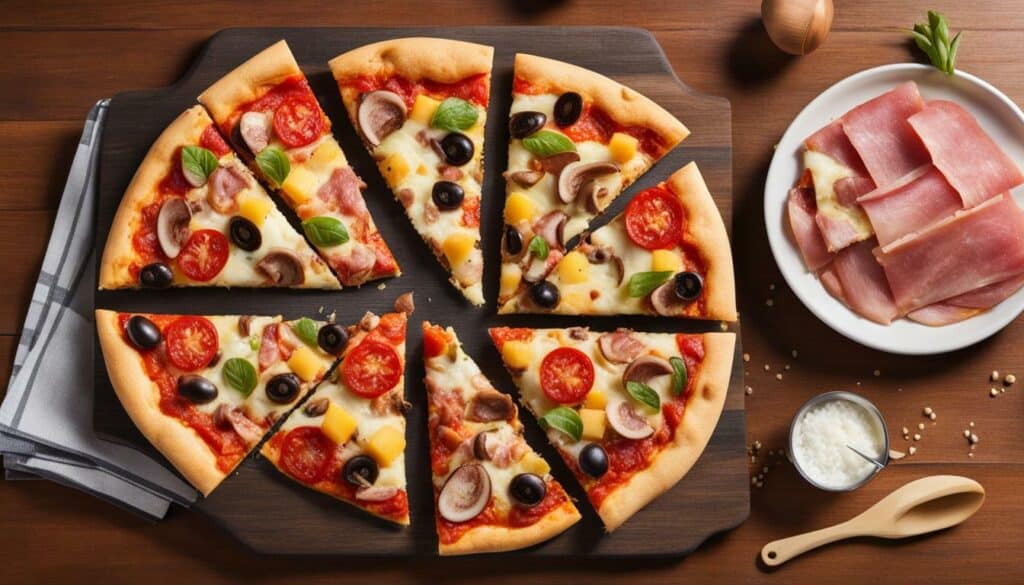
If you’re looking for the best gluten free pizza options, here are some trusted brands that deliver both taste and quality. These brands have made a name for themselves in the gluten-free community and offer a variety of delicious options for those with dietary restrictions.
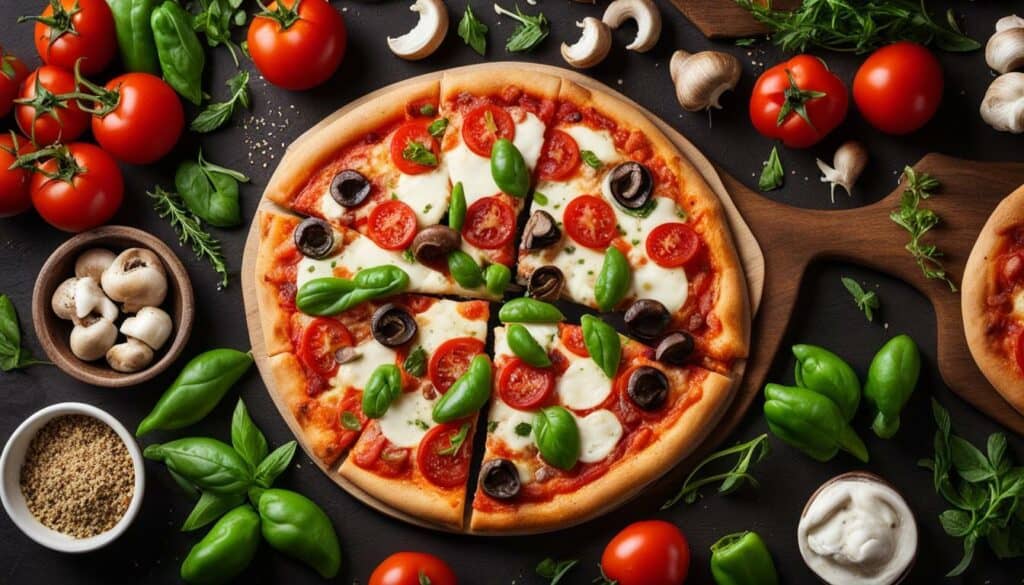
Rudi’s Gluten-Free Bakery
Rudi’s Gluten-Free Bakery is known for its commitment to creating high-quality gluten-free products. Their gluten-free pizza crust is made with wholesome ingredients and has a delicious taste and texture. With a variety of options, including traditional and thin crust, Rudi’s is a popular choice for gluten-free pizza lovers.
Against the Grain Gourmet
Against the Grain Gourmet offers a unique twist on gluten-free pizza. Their pizza crusts are made with simple ingredients like tapioca flour and mozzarella cheese. These crusts have a light and airy texture and are perfect for creating your own customized gluten-free pizza at home.
Cappello’s
Cappello’s is a brand that prides itself on creating delicious gluten-free pizza crusts that taste just like the real thing. Their crusts are made with almond flour and cage-free eggs, resulting in a crispy and flavorful base for your favorite pizza toppings.
These are just a few of the best gluten free pizza brands available. Remember to always check the ingredients and nutritional information to ensure the product fits your dietary needs. Enjoy a slice of gluten-free pizza without compromising on taste and quality!
Making Informed Choices at Gluten Free Pizza Restaurants
When dining out at gluten free pizza restaurants, being aware of your choices can help you stay on track with your calorie goals. While it may be tempting to indulge in your favorite pizza flavors, it’s essential to consider the calorie content and make informed decisions to maintain a healthy diet. Here are some tips to help you make smarter choices when enjoying gluten-free pizza at restaurants:
- Check the menu for gluten-free options: Many pizza restaurants now offer gluten-free crusts as an alternative. Look for specific indications on the menu or ask your server for gluten-free options.
- Opt for thin crust or cauliflower crust: Thin crust pizzas typically have fewer calories than thicker crusts, while cauliflower crusts offer a lower-carb alternative. These options can help you reduce your overall calorie intake.
- Choose vegetable toppings: Load up your pizza with a variety of colorful vegetables. Not only do they add flavor and texture, but they also provide essential nutrients while keeping the calorie count in check.
- Watch portion sizes: Pay attention to the size of the pizza you order. Consider sharing a larger pizza with a friend or opting for a personal-sized pizza to control your portion sizes.
By following these guidelines, you can enjoy a delicious gluten-free pizza at a restaurant while making sure you stay in control of your calorie consumption. Remember, moderation is key, and incorporating healthier choices into your pizza selection can help you maintain a balanced and enjoyable dining experience.
Choosing a Gluten-Free Pizza Restaurant: A Checklist
| What to Consider | Details |
|---|---|
| Variety of gluten-free options | Look for restaurants that offer a wide range of gluten-free pizzas to suit different dietary needs and preferences. |
| Ingredients and toppings | Ensure that the restaurant uses fresh, high-quality ingredients and offers a variety of healthier toppings like vegetables. |
| Cross-contamination prevention | Ask the restaurant about their practices to avoid cross-contamination in the kitchen and during food preparation. |
| Customer reviews | Read reviews from other diners to get an idea of the restaurant’s reputation for gluten-free options, taste, and service. |
| Knowledgeable staff | Choose a restaurant with staff members who are knowledgeable about gluten-free diets and can assist you with any questions or concerns. |

When selecting a gluten-free pizza restaurant, keep these factors in mind to ensure a satisfying and calorie-conscious dining experience. By making informed choices and being mindful of your calorie intake, you can enjoy a delicious gluten-free pizza without compromising your health goals.
The Impact of Gluten Free Pizza Toppings
The toppings you choose for your gluten free pizza can greatly impact the calorie content and overall healthiness of your meal. While gluten free pizza offers a range of options for those with dietary restrictions, it’s important to consider the nutritional profile of your chosen toppings.
When it comes to toppings, opting for healthier choices can help you create a delicious and nutritious gluten free pizza. Incorporating an array of colorful vegetables, such as bell peppers, mushrooms, spinach, and onions, can add flavor, texture, and essential vitamins and minerals to your pizza.
On the other hand, it’s essential to be mindful of high-calorie and high-fat toppings like full-fat cheese, processed meats, and excessive amounts of sauce. These toppings can significantly increase the calorie count of your pizza and may compromise its healthiness.
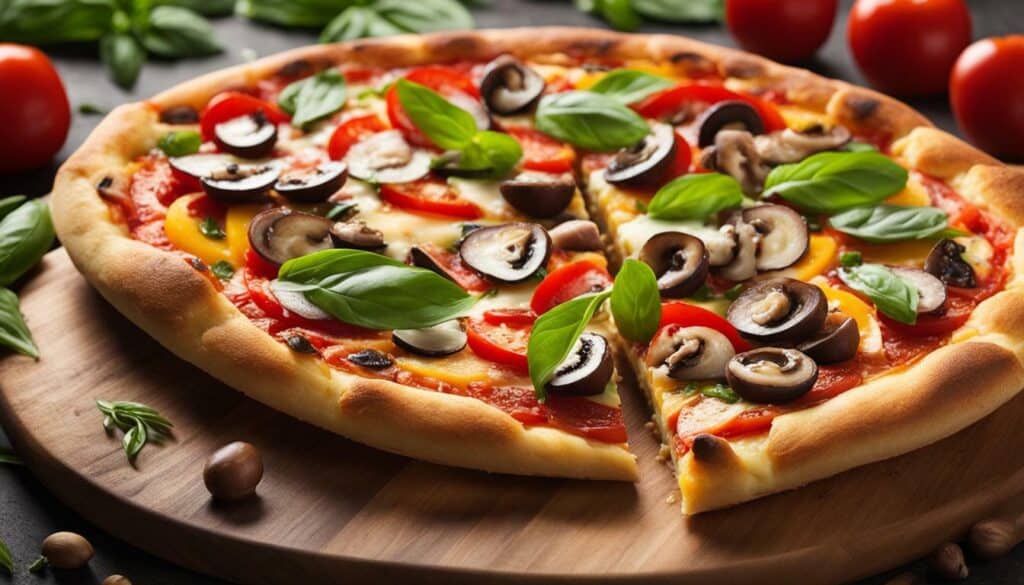
In summary, making thoughtful choices when it comes to gluten free pizza toppings is key to maintaining a healthy and balanced diet. By incorporating nutrient-rich vegetables and opting for lower-calorie toppings, you can enjoy a satisfying gluten free pizza without compromising your calorie intake or overall well-being.
Satisfying Your Pizza Cravings with Healthy Alternatives
If you’re looking to satisfy your pizza cravings while sticking to a healthy gluten-free diet, there are delicious alternatives to consider. Going gluten-free doesn’t mean you have to give up on the joy of pizza. With a little creativity and exploration, you can enjoy a mouthwatering, guilt-free pizza experience.
One popular option for a healthy gluten-free pizza is the cauliflower crust. Made from finely ground cauliflower, this crust provides a nutritious and flavorful alternative to traditional wheat-based crusts. It’s low in calories, high in fiber, and packed with vitamins and minerals. The best part? It’s easy to make at home or readily available at many grocery stores.
Another creative and tasty gluten-free pizza substitute is using portobello mushroom caps as the crust. These large, meaty mushrooms offer a rich and savory base for your toppings. They’re low in calories, carbohydrates, and fat, making them an excellent choice for those looking to cut back on their calorie intake.
To add more variety to your gluten-free pizza options, consider exploring alternative flours such as chickpea flour, almond flour, or even a combination of different gluten-free flours. These flours provide a unique and delicious flavor profile to your pizza crust, while also offering nutritional benefits.
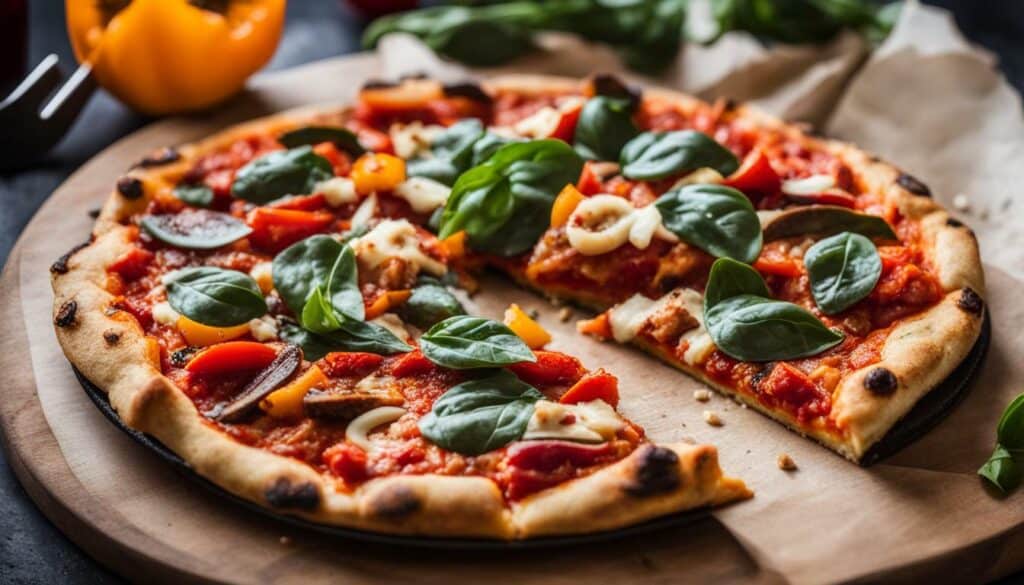
If you prefer to make your own gluten-free pizza at home, the possibilities are endless. Experiment with different crust recipes and toppings to discover your favorite combination. Get creative with vegetable-based toppings like roasted peppers, caramelized onions, or fresh arugula. These add flavor and nutrition to your pizza without piling on the calories.
Remember to practice portion control when enjoying your gluten-free pizza, as even healthier alternatives can still contribute to calorie intake. A balanced approach to eating and regular exercise are key to maintaining a healthy lifestyle while satisfying your pizza cravings.
So, the next time you’re craving pizza, don’t worry about gluten. With these healthy alternatives and a little culinary exploration, you can indulge in a delicious and guilt-free pizza experience.
Conclusion
Counting gluten-free pizza calories is essential for maintaining a healthy diet, and with the right choices, you can still indulge in your favorite treat while staying on track. The calorie content of gluten-free pizza varies depending on factors such as crust type, toppings, and slice size. It is crucial to be aware of these factors and make informed decisions when enjoying gluten-free pizza.
One way to reduce the calorie count of gluten-free pizza is by choosing low-calorie ingredients and toppings. Opt for part-skim cheese and load up on vegetables to add flavor without adding excessive calories. Additionally, practicing portion control is vital as even gluten-free pizza can be high in calories, fat, and sodium. By being mindful of your serving size, you can enjoy a satisfying slice without overindulging.
When dining out, it is important to navigate gluten-free pizza restaurant menus wisely. Look for options that offer healthier crusts and toppings, and be aware of any hidden ingredients that may contribute to higher calorie content. Trustworthy gluten-free pizza brands can also provide delicious and nutritious alternatives if you prefer to enjoy pizza at home.
In conclusion, counting gluten-free pizza calories is key to maintaining a balanced diet. By making conscious choices, such as opting for low-calorie ingredients, practicing portion control, and choosing trusted brands or restaurant options, you can still satisfy your pizza cravings without compromising your health goals. So go ahead and enjoy a guilt-free and delicious gluten-free pizza experience!
FAQ
Q: Why is counting gluten-free pizza calories important?
A: Counting gluten-free pizza calories is important for individuals who are conscious of their calorie intake. It helps them make informed choices and maintain a healthy diet.
Q: How does the calorie content of gluten-free pizza vary?
A: The calorie content of gluten-free pizza can vary depending on the type of crust, toppings, and size of the slice. It’s important to consider these factors when counting calories.
Q: What are some low-calorie ingredients and toppings for gluten-free pizza?
A: To reduce the calorie count, opt for low-calorie ingredients like part-skim cheese and healthier toppings such as vegetables.
Q: Why is portion control important when consuming gluten-free pizza?
A: Even though it may be gluten-free, pizza can still be high in fat, calories, and sodium. Practicing portion control is key to maintaining a healthy balance.
Q: What are some trusted gluten-free pizza brands?
A: Some top gluten-free pizza brands include XYZ, ABC, and DEF. These brands offer delicious and nutritious options for gluten-free pizza lovers.
Q: How can I make informed choices when dining at gluten-free pizza restaurants?
A: When dining out, look for menu items that specify gluten-free options and ask about ingredient choices. This will help you make healthier choices at gluten-free pizza restaurants.
Q: Do different gluten-free pizza toppings impact the calorie count?
A: Yes, different toppings can contribute to the overall calorie count. Choosing healthier toppings like vegetables can help reduce calories while still enjoying gluten-free pizza.
Q: Are there healthier alternatives to traditional gluten-free pizza?
A: Yes, there are alternatives like cauliflower crust and other creative gluten-free substitutes that can still satisfy your pizza cravings in a healthier way.
Q: What is the key takeaway regarding gluten-free pizza calories?
A: Counting gluten-free pizza calories, making informed choices, and practicing moderation are key to enjoying gluten-free pizza while maintaining a healthy diet.
Can Tracking Gluten Free Pizza Calories Help Maintain a Balanced Diet?
Tracking pepperoni pizza calories can be a useful tool in maintaining a balanced diet, especially for those following a gluten-free lifestyle. By monitoring the calorie content of gluten-free pizza options, individuals can make informed choices and ensure they stay within their calorie limits. However, it is important to remember that a balanced diet should also include a variety of other nutritious foods to meet all dietary needs.

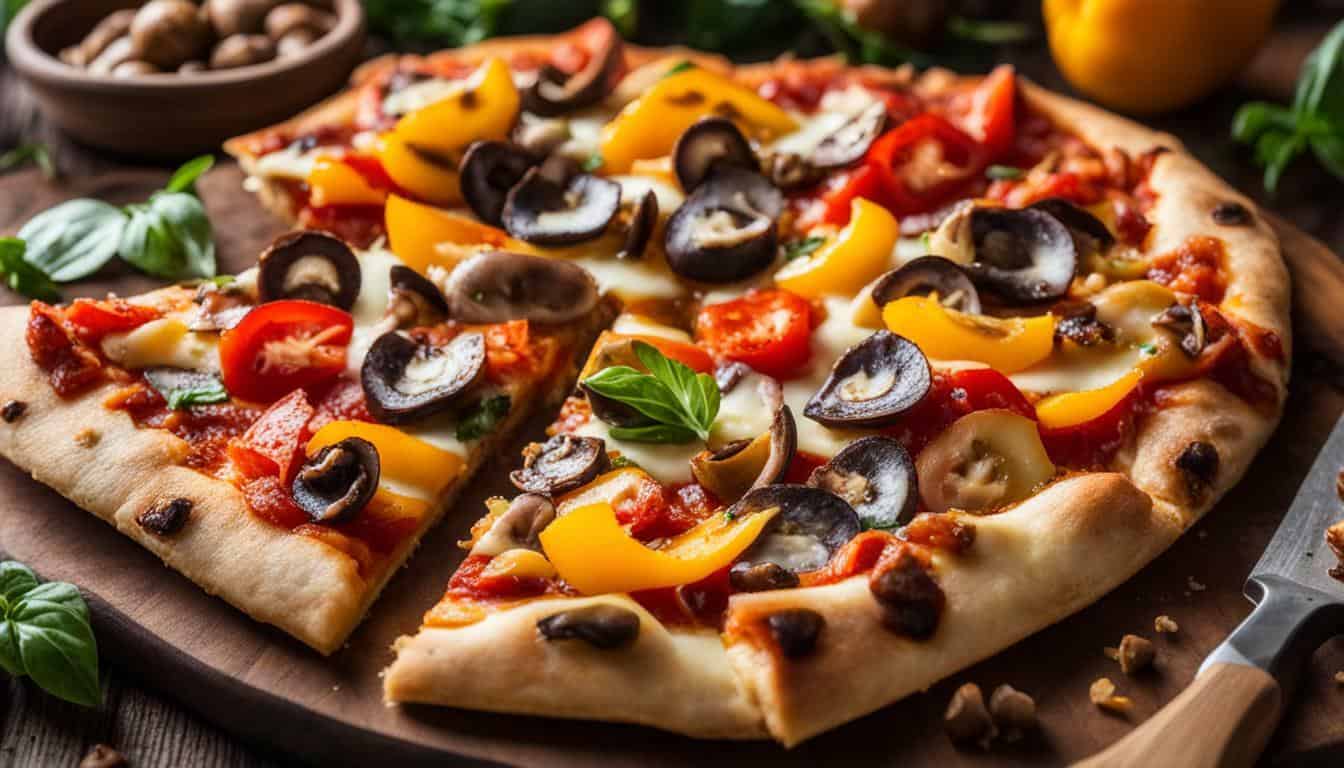



Leave a Reply